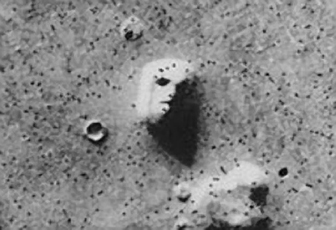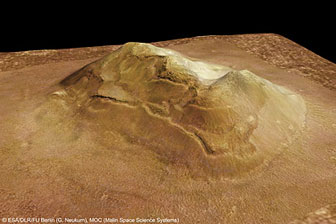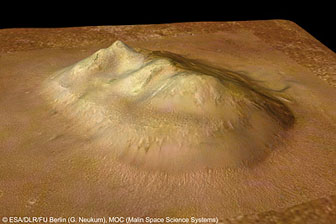Mars face photo dashes hope for existence of Martians
Mars face photo dashes hope for existence of Martians
mongabay.com
September 24, 2006
New images from the European Space Agency (ESA) show that the Red Planet’s famous “Face on Mars” is nothing but a eroded hill.
 Original ‘Face on Mars’ image taken by NASA’s Viking 1 orbiter, in gray scale, on 25 July 1976.  A second perspective view showing the so-called ‘Face on Mars’ located in Cydonia region. The image shows a remnant massif thought to have formed via landslides and an early form of debris apron formation. The massif is characterized by a western wall that has moved downslope as a coherent mass. The massif became famous known as the ‘Face on Mars’ in a photo taken on 25 July 1976 by the American Viking 1 Orbiter. Text and image courtesy of ESA.  A perspective view showing the so-called ‘Face on Mars’ located in the Cydonia region. The image shows a remnant massif thought to have formed via landslides and an early form of debris apron formation. The massif is characterized by a western wall that has moved downslope as a coherent mass. The massif became famous as the ‘Face on Mars’ in a photo taken on 25 July 1976 by the American Viking 1 Orbiter. Text and image courtesy of ESA. |
The Face on Mars myth is based on a photo of Mars’ Cydonia region taken by NASA’s Viking probes in 1976. In the picture, the rock formation gives the appearance of a human face “formed by shadows giving the illusion of eyes, nose and mouth” as described in a NASA news release from July 31st, 1976.
ESA’s new photos come after multiple attempts to image the Cydonia region between April 2004 and July 2006 were “frustrated by altitude and atmospheric dust and haze” according to the agency.
“These images of the Cydonia region on Mars are truly spectacular,” said Dr Agustin Chicarro, ESA Mars Express Project Scientist. “They not only provide a completely fresh and detailed view of an area famous to fans of space myths worldwide, but also provide an impressive close-up over an area of great interest for planetary geologists, and show once more the high capability of the Mars Express camera.”
A news release, “Cydonia – the face on Mars” from ESA explains the history of the face in pop culture.
On 31 July 1976, a NASA press release said the formation “resembles a human head.” However, NASA scientists had already correctly interpreted the image as an optical illusion caused by the illumination angle of the Sun, the formation’s surface morphology and the resulting shadows, giving the impression of eyes, nose and mouth.
Nonetheless, the ‘Face on Mars’ was the subject of widespread speculation on the possible origins and purpose of artificial structures on the Red Planet, with the face being the most talked-about formation.
The array of nearby structures has been interpreted by some space enthusiasts as artificial landscapes, such as potential pyramids and even a disintegrated city. The idea that the planet might have once been home to intelligent beings has since inspired the imagination of many Mars fans, and has been expressed in numerous, more-or-less serious, newspaper articles as well as in science-fiction literature and on many Web pages.
Despite all this, the formal scientific interpretation has never changed: the face remains a figment of human imagination in a heavily eroded surface.